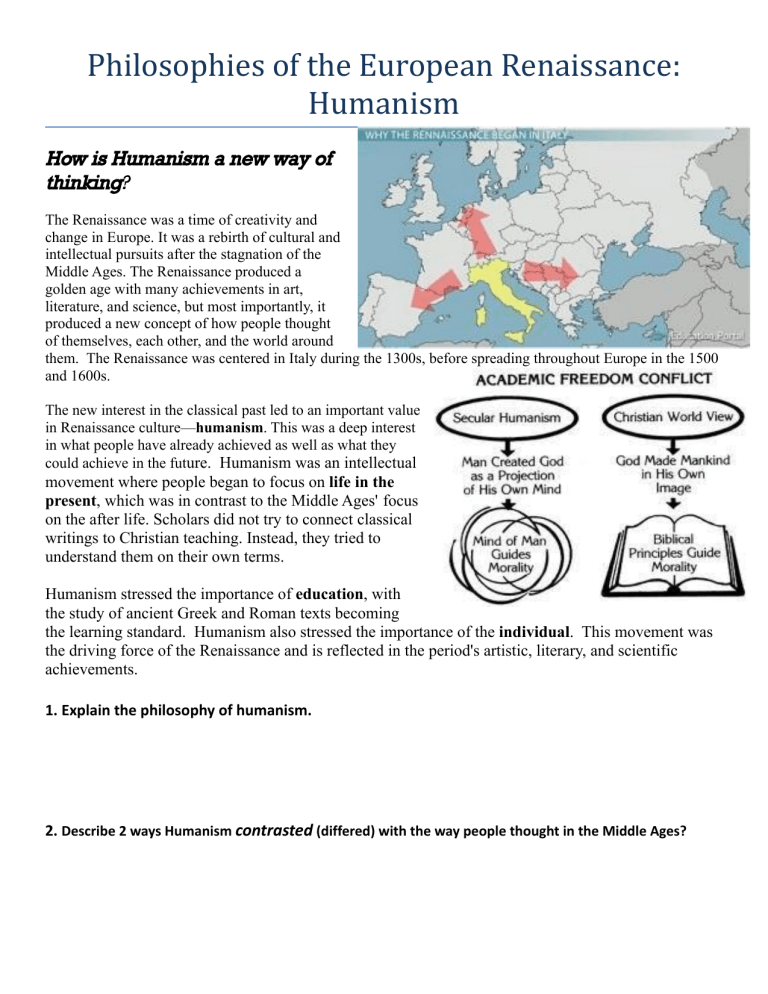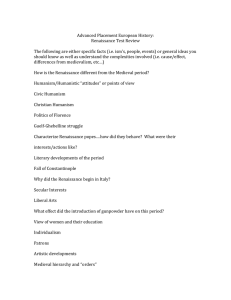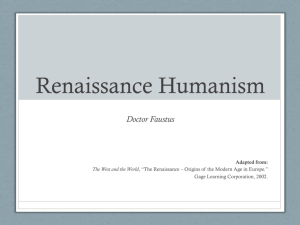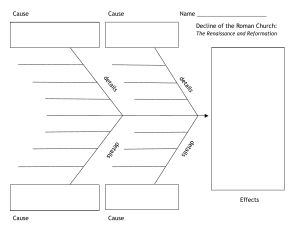
Philosophies of the European Renaissance: Humanism How is Humanism a new way of thinking? The Renaissance was a time of creativity and change in Europe. It was a rebirth of cultural and intellectual pursuits after the stagnation of the Middle Ages. The Renaissance produced a golden age with many achievements in art, literature, and science, but most importantly, it produced a new concept of how people thought of themselves, each other, and the world around them. The Renaissance was centered in Italy during the 1300s, before spreading throughout Europe in the 1500 and 1600s. The new interest in the classical past led to an important value in Renaissance culture—humanism. This was a deep interest in what people have already achieved as well as what they could achieve in the future. Humanism was an intellectual movement where people began to focus on life in the present, which was in contrast to the Middle Ages' focus on the after life. Scholars did not try to connect classical writings to Christian teaching. Instead, they tried to understand them on their own terms. Humanism stressed the importance of education, with the study of ancient Greek and Roman texts becoming the learning standard. Humanism also stressed the importance of the individual. This movement was the driving force of the Renaissance and is reflected in the period's artistic, literary, and scientific achievements. 1. Explain the philosophy of humanism. 2. Describe 2 ways Humanism contrasted (differed) with the way people thought in the Middle Ages? How does Humanist thinking lead to cultural achievements? In the Middle Ages, the emphasis had been mostly on spiritual values. Renaissance thinkers stressed secular ideas. These ideas centered on the things of the world. One way that powerful or wealthy people showed this interest in worldly things was by paying artists, writers, and musicians to create beautiful works of art. Wealthy people who supported artists were known as patrons. People tried to show that they could master many fields of study or work. This is now known as being a Renaissance man. Individuals who succeeded in many fields were admired greatly. The artist Leonardo da Vinci was an example of this ideal. He was a painter, a scientist, and an inventor. A humanist's goal was to reach the height of their human potential. Men of the Renaissance were expected to be charming, witty, well educated, well mannered, athletic, and self controlled. Women were expected to have many accomplishments, too. But women were not to show them in public in what was a very male dominated society. 3. What are secular ideas? 4. What is the goal of Humanists? Review-highlight the answer the best answers the question 5. Which term is defined as a Renaissance movement characterized by independent thought and a renewed interest in classical Greek and Roman culture? (1) multiculturalism (2) humanism (3) nationalism (4) monasticism 6. The revival of Greek and Roman culture, the economic growth of Italian city-states in the 1400s, and the development of humanism were aspects of the (1) Age of Revolutions (2) Protestant Reformation (3) spread of Islam (4) European Renaissance 7. In the Renaissance period, which factor was emphasized by the philosophy of humanism? (1) (2) (3) (4) superiority of medieval thought devotion to religion value of the individual obedience to government officials 8. European society during the renaissance differed from European society during the Middle Ages in that during the Renaissance (1) (2) (3) (4) the Church was no longer influential the emphasis on individual worth increased economic activity declined art no longer contained religious themes How does humanism affect people’s thinking about social standing? Humanists’ ideals also affected people's thinking about social standing. In feudal times, people were born into a certain status in society. If someone was born a peasant, he or she would always have less status than a noble. Renaissance thinkers prized individual achievement more than a person’s class or family. This emphasis on individualism was an enormous shift from medieval thinking. 9. How did social status (standing) differ from feudal times to the period of the Renaissance? Humanism and the Catholic Church The humanists’ new ideas sometimes brought them into conflict with the Catholic Church. The church taught that laws were made by God and that those who broke them were sinful. It encouraged people to follow the teachings without question in order to save their souls. For the church, life after death was more important than life on Earth. In contrast, humanists believed that people should use their minds to question everything. Most tried to balance religious faith and its emphasis on the afterlife with an active interest in daily life. Some directly challenged teachings that were dear to the church. 10. How was religion different in the Renaissance compared to Medieval times?






